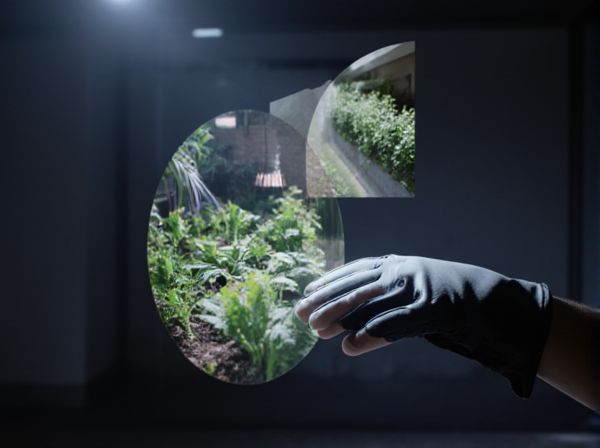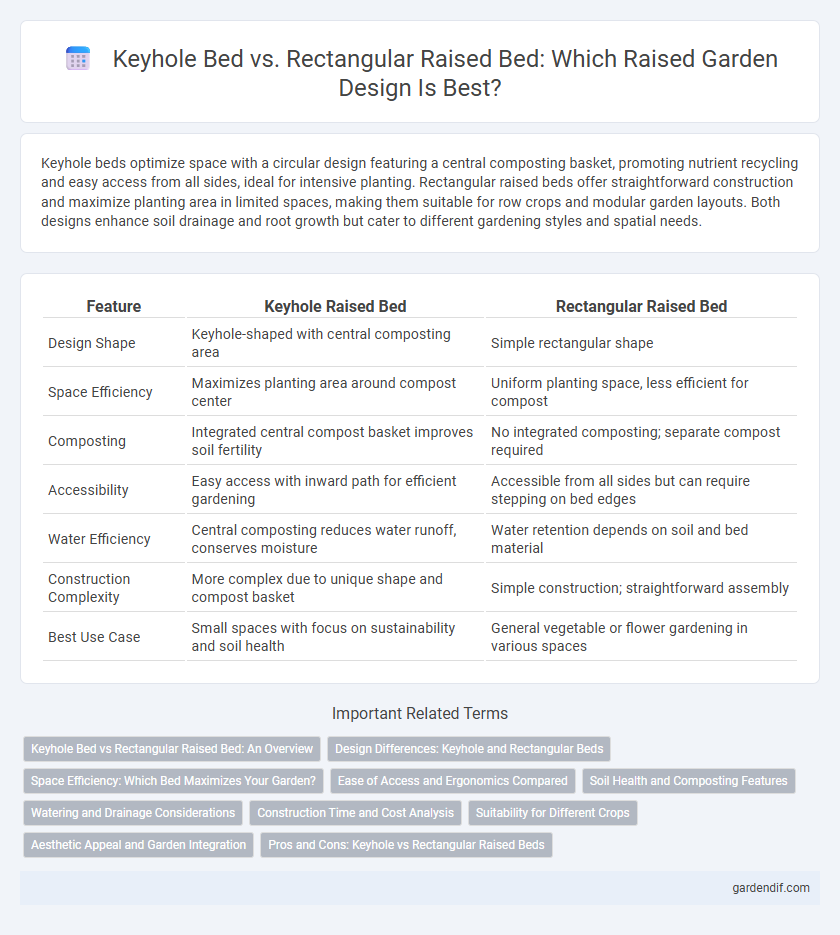
Keyhole bed vs Rectangular raised bed Illustration
Keyhole beds optimize space with a circular design featuring a central composting basket, promoting nutrient recycling and easy access from all sides, ideal for intensive planting. Rectangular raised beds offer straightforward construction and maximize planting area in limited spaces, making them suitable for row crops and modular garden layouts. Both designs enhance soil drainage and root growth but cater to different gardening styles and spatial needs.
Table of Comparison
| Feature | Keyhole Raised Bed | Rectangular Raised Bed |
|---|---|---|
| Design Shape | Keyhole-shaped with central composting area | Simple rectangular shape |
| Space Efficiency | Maximizes planting area around compost center | Uniform planting space, less efficient for compost |
| Composting | Integrated central compost basket improves soil fertility | No integrated composting; separate compost required |
| Accessibility | Easy access with inward path for efficient gardening | Accessible from all sides but can require stepping on bed edges |
| Water Efficiency | Central composting reduces water runoff, conserves moisture | Water retention depends on soil and bed material |
| Construction Complexity | More complex due to unique shape and compost basket | Simple construction; straightforward assembly |
| Best Use Case | Small spaces with focus on sustainability and soil health | General vegetable or flower gardening in various spaces |
Keyhole Bed vs Rectangular Raised Bed: An Overview
Keyhole beds feature a circular design with a central composting basket, optimizing space and improving soil fertility through easy access to nutrients, while rectangular raised beds offer a straightforward, space-efficient layout suited for row planting and easy irrigation. The keyhole bed's ergonomic shape reduces walking paths, enhancing garden accessibility, whereas rectangular beds maximize planting area, ideal for larger crops and structured garden planning. Choosing between keyhole and rectangular raised beds depends on goals like maximizing nutrient recycling or optimizing planting density and maintenance ease.
Design Differences: Keyhole and Rectangular Beds
Keyhole beds feature a circular design with a central composting basket, allowing easy access to all parts of the bed without stepping inside, which promotes better soil structure and plant health. Rectangular raised beds offer a straightforward, linear layout that maximizes planting space and simplifies construction, making them ideal for row crops and organized garden layouts. The keyhole bed's unique shape optimizes nutrient distribution and water retention through its central composting system, whereas rectangular beds rely on traditional soil amendment methods spread evenly across the bed.
Space Efficiency: Which Bed Maximizes Your Garden?
Keyhole beds maximize garden space by incorporating a central composting basket, allowing easier access to plants without compacting soil and enabling efficient use of a smaller footprint. Rectangular raised beds, while offering straightforward layout and scalability, may require more walking paths and separation between beds, reducing overall planting area efficiency. For gardeners aiming to optimize space and accessibility simultaneously, keyhole beds present a superior solution in confined or intensive gardening environments.
Ease of Access and Ergonomics Compared
Keyhole beds offer superior ease of access with a central path allowing gardeners to reach all planting areas without stepping on the soil, promoting better soil health and ergonomics by minimizing bending and stretching. Rectangular raised beds may require more movement along edges and frequent bending, which can cause strain and reduce efficiency during planting and maintenance. The design of keyhole beds enhances ergonomic benefits, making them ideal for gardeners seeking comfort and accessibility in their raised bed gardening.
Soil Health and Composting Features
Keyhole beds enhance soil health through a central composting basket that evenly distributes nutrients and moisture, promoting microbial activity and reducing soil erosion. Rectangular raised beds rely on external compost applications, which can lead to inconsistent nutrient distribution and slower organic matter integration. The design of keyhole beds supports continuous composting directly within the bed, fostering improved soil structure and fertility over time.
Watering and Drainage Considerations
Keyhole beds feature a central composting basket that enhances moisture retention and reduces water runoff, promoting efficient watering and natural drainage. Rectangular raised beds typically require more frequent watering due to less optimized moisture distribution and can experience uneven drainage if soil composition is inconsistent. Proper soil amendments and irrigation practices are essential for both bed types to maintain optimal hydration and prevent waterlogging or drought stress.
Construction Time and Cost Analysis
Keyhole beds require more intricate construction with central composting areas, often increasing build time and material costs compared to rectangular raised beds. Rectangular raised beds feature simpler designs, enabling faster assembly and generally lower expenses due to reduced complexity and standard materials. Evaluating labor hours and budget constraints, rectangular beds offer a more cost-effective solution for efficient gardening setups.
Suitability for Different Crops
Keyhole beds suit intensive gardening with herbs and leafy greens due to their central composting area, promoting nutrient-rich soil. Rectangular raised beds offer versatility, ideal for root vegetables and sprawling plants that require more space for growth. Crop rotation and companion planting adapt better in rectangular beds, optimizing yield for a variety of crops.
Aesthetic Appeal and Garden Integration
Keyhole beds offer a visually striking, circular design that enhances garden aesthetics by creating a focal point and promoting organic garden flow. Rectangular raised beds provide a classic, orderly appearance that integrates seamlessly into traditional garden layouts and maximizes planting efficiency. Both designs support diverse planting styles, with keyhole beds favoring sculptural impact and rectangular beds ensuring structured garden harmony.
Pros and Cons: Keyhole vs Rectangular Raised Beds
Keyhole raised beds offer enhanced water efficiency and soil aeration due to their central composting basket, making them ideal for small spaces and intensive gardening, but they can be more complex to build compared to rectangular raised beds. Rectangular raised beds provide straightforward construction and better scalability for larger gardens, with easier access to crops from all sides, yet they may require more frequent watering and soil amendments as composting is external. Choosing between keyhole and rectangular designs depends on space availability, maintenance preferences, and yield goals, with keyhole beds excelling in nutrient recycling and water conservation while rectangular beds favor simplicity and flexibility.
Keyhole bed vs Rectangular raised bed Infographic

 gardendif.com
gardendif.com